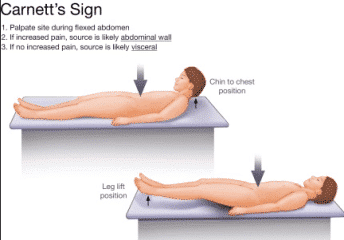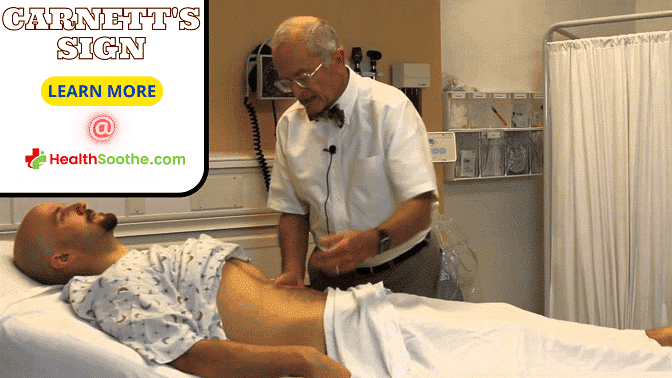About the Carnetts Sign

Carnett's sign is a clinical finding in which (acute) abdominal discomfort stays unaltered or worsens while the abdominal wall muscles are strained. To tighten the abdominal muscles, the patient may be requested to elevate his or her head and shoulders off the examination table during this section of the examination.
Another option is to request that the patient elevate both legs with straight knees. A positive Carnetts sign suggests that the abdominal wall, rather than the abdominal cavity, is the cause of the discomfort (for example, due to rectus sheath hematoma instead of appendicitis).
A negative Carnett's sign is claimed to occur when the patient's stomach discomfort lessens when requested to elevate the head, indicating an intra-abdominal origin of the pain.
The Etymology and History of Carnett’s Sign
In May 1926, an American physician named John Berton Carnett (1890-1988) reported the Carnetts sign. Edgar Ferdinand Cyriax published the first unambiguous description of anterior abdominal wall discomfort caused by entities other than the underlying viscera in 1919.
Pain, according to Cyriax, may be imitated by lesions arising from the spine, ribs, or other connected structures, or it could be caused by direct stimulation of intercostal nerves.
He was able to repair the anomalies and cure his patients' symptoms by recognizing situations such as changes in normal vertebral curves, mild subluxation of vertebral bodies, and pressure on the peripheral sections of the intercostal nerves.
Despite this study, this topic received little attention until Carnett created his simple clinical test. Carnett believed that lower abdomen pain was often induced by the lower six thoracic nerves and wished to be able to separate this origin from visceral discomfort.
The Differential Diagnosis of Carnetts Sign

Thoracic disk herniations, sliding rib syndrome, nerve entrapment syndrome, irritation of intercostal nerve roots, trigger points, anterior cutaneous nerve entrapment, myofascial pain, hernias, and rectus sheath hematomas are among the possible causes of a positive Carnett's sign test.
Carnett's sign test may be effective in evaluating abdominal wall hernias since they are invariably accompanied with discomfort. Epigastric hernias, umbilical hernias, spigelian hernias, and incisional hernias are examples of anterior abdominal wall hernias.
Femoral hernia, indirect inguinal hernia, direct inguinal hernia, and sports hernia are examples of groin hernias. Obturator hernia, sciatic hernia, and perineal hernia are examples of pelvic wall hernias. Vault prolapse, rectocele, cystocele, enterocele, and uterine decensus are examples of support hernias.
Although most hernias are clinically detectable by the appearance of a lump with an expansile cough impulse, others may be difficult to notice due to their small size or the patient's obesity. Additional examination using radiography or ultrasonography may be beneficial in circumstances when the diagnosis is suspected but clinically unproven.
Herniography, which involves inserting contrast material into the peritoneal cavity, has been used effectively to discover previously undetected inguinal hernias in patients with groin discomfort of unknown origin, as well as impalpable interparietal lesions such as Spigelian hernias.
Slipping rib syndrome is characterized by discomfort along the costal border and is caused by inter-chondral laxity of the eighth, ninth, and tenth ribs. These ribs do not articulate with the sternum and are instead connected by a narrow band of fibrous tissue. If this fibrous connection dislocates, the rib(s) may ride up and irritate the intercostal nerve(s), resulting in discomfort.
As the ribs move relative to one another, the patient may experience a popping or clicking sensation. The "hooking technique," in which the examiner hooks their fingers under the costal border and pulls upwards, might mimic the symptoms.
The rupture of the epigastric vessels causes spontaneous rectus sheath hematoma. The patient frequently complains of acute well-localized stomach discomfort with a sensitive non-pulsatile abdominal mass, commonly in the lower abdomen.
A probable triggering cause, such as local trauma, an episode of coughing, or anticoagulant medication, is typically present. If the hematoma does not expand, an ultrasound scan may confirm the diagnosis and a conservative approach to therapy can be used. Carnetts sign test may be useful in this situation.
You can watch the video below to know more about the carnetts sign:
The Summary
The Carnetts sign refers to an examination finding used to differentiate discomfort from the abdominal wall from pain from inside the abdomen.
The process for eliciting the Carnett’s sign was characterized as two stages. First, the examiner palpates the abdomen in the normal method while the patient's abdominal muscles are relaxed, then asks the patient to contract their abdominal muscles (for example, by raising their head off the pillow) and applies pressure to the same area.
If the soreness persists with the rectus muscles tightened, the discomfort is most likely to originate in the abdomen wall, such as from a rectus sheath hematoma.
All right, guys, that is it for now for Carnett’s sign. I hope Healthsoothe answered any questions you had concerning Carnetts sign.
Feel free to contact us at contact@healthsoothe.com if you have further questions to ask or if there’s anything you want to contribute or correct to this article.
You can always check our FAQs section below to know more about Carnetts sign. And always remember that Healthsoothe is one of the best health sites out there that genuinely cares for you. So, anytime, you need trustworthy answers to any of your health-related questions, come straight to us, and we will solve your problem(s) for you.
Frequently Asked Questions Related to Carnetts Sign
What does a positive Carnetts sign mean?
Having a positive Carnett sign means that the abdominal pain gets worse when the abdominal wall gets more tense, suggesting a somatic type of pain. A negative Carnett sign suggests an intra-abdominal cause of pain (visceral).
What is abdominal rigidity a sign of?
Causes can include:
- Abscess inside the abdomen. Appendicitis.
- Cholecystitis caused by gallstones.
- Hole that develops through the entire wall of the stomach, small intestine, large bowel, or gallbladder (gastrointestinal perforation).
What does anterior cutaneous nerve entrapment syndrome feel like?
Pain with pinching the skin in that spot, but not in other places. pain and tenderness with tapping and pressing on that spot, but not in other places. a positive Carnett's sign, which is tenderness to pressing that worsens when your child tenses their abdomen by either lifting their head and shoulders or legs.

